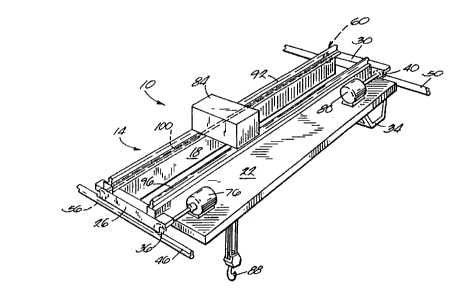Some of the information on this Web page has been provided by external sources. The Government of Canada is not responsible for the accuracy, reliability or currency of the information supplied by external sources. Users wishing to rely upon this information should consult directly with the source of the information. Content provided by external sources is not subject to official languages, privacy and accessibility requirements.
Any discrepancies in the text and image of the Claims and Abstract are due to differing posting times. Text of the Claims and Abstract are posted:
| (12) Patent: | (11) CA 2140189 |
|---|---|
| (54) English Title: | APPARATUS FOR CORRECTING SKEW OF A TRAVELING CRANE |
| (54) French Title: | APPAREIL UTILISE POUR CORRIGER L'OBLIQUITE D'UN PONT ROULANT |
| Status: | Expired |
| (51) International Patent Classification (IPC): |
|
|---|---|
| (72) Inventors : |
|
| (73) Owners : |
|
| (71) Applicants : | |
| (74) Agent: | RIDOUT & MAYBEE LLP |
| (74) Associate agent: | |
| (45) Issued: | 1999-02-16 |
| (22) Filed Date: | 1995-01-13 |
| (41) Open to Public Inspection: | 1996-05-22 |
| Examination requested: | 1995-01-13 |
| Availability of licence: | N/A |
| (25) Language of filing: | English |
| Patent Cooperation Treaty (PCT): | No |
|---|
| (30) Application Priority Data: | ||||||
|---|---|---|---|---|---|---|
|
An overhead traveling crane adapted to be supported on a
pair of spaced apart, generally parallel first and second rails,
the crane comprising a frame having opposite first and second
ends, a first drive wheel which is rotatably mounted on the first
end of the frame and which is adapted to roll along the first
rail, a first idler wheel which is rotatably mounted on the first
end of the frame and which is adapted to roll along the first
rail, a second drive wheel which is rotatably mounted on the
second end of the frame and which is adapted to roll along the
second rail, a second idler wheel which is rotatably mounted on
the second end of the frame and which is adapted to roll along
the second rail, a first motor mounted on the frame and drivingly
connected to the first drive wheel, a second motor mounted on the
frame and drivingly connected to the second drive wheel, an idler
shaft connecting the idler wheels such that the idler wheels
rotate at the same speed, a hoist moveable along the frame in a
direction generally perpendicular to the rails, and a load
engaging mechanism which is raised and lowered by the hoist.
La présente invention a pour objet un pont roulant destiné à être supporté par un premier et un deuxième rails espacés et essentiellement parallèles; le pont roulant est constitué des éléments suivants : un bâti comportant une première et une deuxième extrémités opposées, une première roue motrice en montage rotatif sur la première extrémité du bâti et destinée à rouler le long du premier rail, une première roue intermédiaire en montage rotatif sur la première extrémité du bâti et destinée à rouler le long du premier rail, une deuxième roue motrice en montage rotatif sur la deuxième extrémité du bâti et destinée à rouler le long du deuxième rail, une deuxième roue intermédiaire en montage rotatif sur la deuxième extrémité du bâti et destinée à rouler le long du deuxième rail, un premier moteur monté sur le bâti et en couplage mécanique avec la première roue motrice, un deuxième moteur monté sur le bâti et en couplage mécanique avec la deuxième roue motrice, un arbre d'interconnexion reliant les roues intermédiaires et assurant leur rotation solidaire à une même vitesse, un premier treuil mobile en déplacement le long du bâti dans une direction essentiellement perpendiculaire aux rails, ainsi qu'un mécanisme de prise de la charge dont le relèvement et l'abaissement sont effectués par le treuil.
Note: Claims are shown in the official language in which they were submitted.
Note: Descriptions are shown in the official language in which they were submitted.

For a clearer understanding of the status of the application/patent presented on this page, the site Disclaimer , as well as the definitions for Patent , Administrative Status , Maintenance Fee and Payment History should be consulted.
| Title | Date |
|---|---|
| Forecasted Issue Date | 1999-02-16 |
| (22) Filed | 1995-01-13 |
| Examination Requested | 1995-01-13 |
| (41) Open to Public Inspection | 1996-05-22 |
| (45) Issued | 1999-02-16 |
| Expired | 2015-01-13 |
There is no abandonment history.
Note: Records showing the ownership history in alphabetical order.
| Current Owners on Record |
|---|
| MHE TECHNOLOGIES, INC. |
| Past Owners on Record |
|---|
| HARNISCHFEGER CORPORATION |
| THORSEN, GEORGE E. |